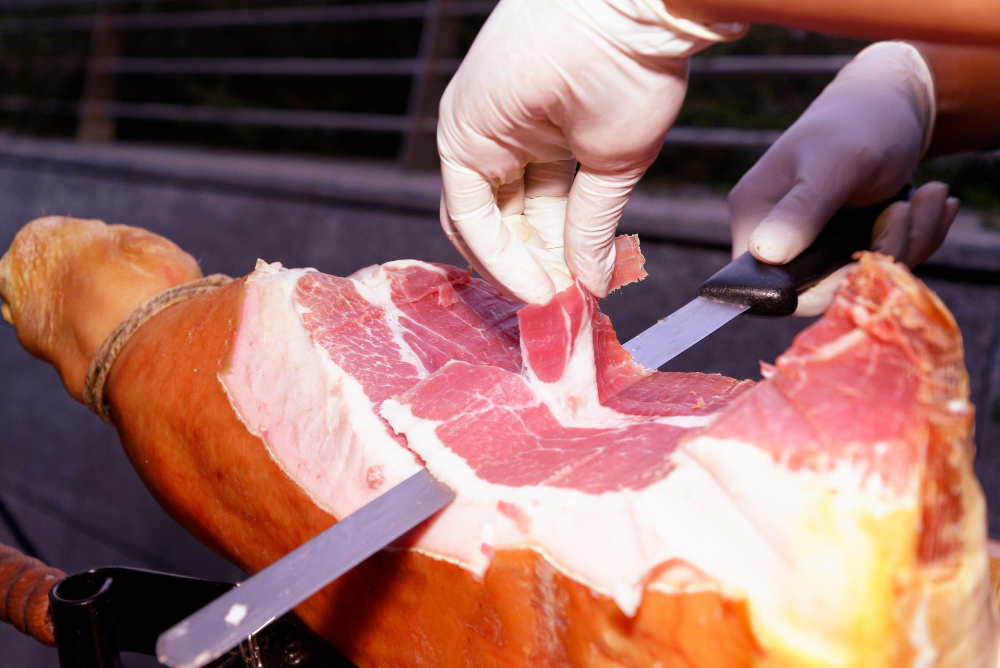Cappacuolo: A Guide to Delicious Italian Cured Meat
In Short
- Unlike prosciuttini, cappacuolo is made with pig neck or shoulder flesh. This part of the pig called the “coppa,” has the right fat-meat ratio, making cappacuolo delicious.
- Cure, season, and salt cappacuolo for months to prevent hazardous bacteria development and make it safe to consume.
- Pork neck and shoulders are used to make cappacuolo. This 2.5-gram muscle has the right meat-fat ratio
- Italians love cappacuolo, a delectable cured pork. It’s been manufactured since prehistoric times! This guide covers everything about cappacuolo.
Salt has traditionally been used to cure meat. Before refrigeration, the Mesopotamians did this to preserve meat and fish circa 3000 BC. By the Roman Empire, meat curing was widespread. The Romans cured and dried several foods. These preserved meat preparations were useful at home, on lengthy trips, and in religious rites. Italy’s favourite cured meat was a pig, even as the variety grew. Salumi, Italian cured pork products, number in the hundreds. Either large slices of meat are salted and aged for months, or fragments of flesh are seasoned and stuffed into casings to age. First, cappacuolo is completely muscle treated.
| Pros | Cons |
| High in protein | High in fat and saturated fat |
| Good source of iron and vitamin B12 | High sodium content |
| The bold, complex flavour profile | May contain nitrites (potential cancer risk) |
| Versatile for cooking/recipes | |
| Long shelf-life |
What Is Cappacuolo?
Cappacuolo is cured pig shoulder meat or ham. The muscle linking the head (capo) to the shoulder (collo) of the pig extends from the neck to the fourth or fifth rib, thus its name. This shoulder cut features a 70/30 lean-to-fat ratio. Since cappacuolo has more fat than other cured meats, it’s juicy and soft. Traditional pork shoulder brining includes garlic, wine, herbs, and spices. After brining, it’s salted and cooled. Rinse it and season it with red pepper, fennel, coriander, paprika, and anise. Stuffing seasoned pork into a natural pork casing and hang to air-dry and cure for 4-6 months. cappacuolo can be eaten as-is or smoked or slow-roasted to produce coppa cotta. In the past, cappacuolo was made in Piacenza and Calabria. These two regions now have Protected Designation of Origin designation for authentic cappacuolo from the EU.
How Does cappacuolo Look?
Depending on the pork shoulder used, a cappacuolo can weigh 2-3 pounds. A cappacuolo matured for 4-6 months loses 35% of its moisture during curing. cappacuolo looks distinct from sausage-style salumi prepared with mixed meat bits. The fat marbling in the thinner meat sections is obvious since it starts as a full pig muscle. The flesh is brilliant crimson in some places and salmon-coloured in others. The cappacuolo’s spice combination permeates the outside borders when thinly sliced. Some with a lot of red pepper and paprika have an orange exterior. Plainer seasoned types have less outside colour. Smoked or roasted coppa cotta has a mellow internal hue without seasoning highlights. The fat marbling is opaque and off-white, unlike raw cappacuolo’s brighter white fat striations.
How Does cappacuolo Taste?
Because of the pork shoulder cut, cappacuolo tastes nuanced and wonderful. While chewy, its larger fat content gives it a richer, creamier taste than thinner cured meats. Some sausage-style salumi is rough and gristly, but not this. cappacuolo becomes even softer and moister when smoked or baked into coppa cotta as the fat dissolves away. The chewiness is reduced by dry-curing. Cappacuolo smells sweet, peppery, and porky, almost bacon-like, especially when smoked. The taste comes through when you bite into a piece. The fennel, coriander, anise, pepper, garlic, and wine flavours will become apparent as the meat heats from your body heat. Curing adds a nice salinity. cappacuolo’s umami taste makes it craveable whether you’re Italian or not! Unique combination of creamy unctuousness, delicate spices, salt, and delicious meatiness.
Cappacuolo vs. Prosciutto
Cappacuolo and prosciutto are Italian dry-cured meats, although they differ:
- Cappacuolo utilizes the fatty shoulder, whereas prosciutto uses the thinner rear leg.
- Cappacuolo comes from Calabria, whereas prosciutto comes from Parma and San Daniele.
- Prosciutto legs are much larger than cappacuolos.
- Pork Breed: cappacuolo employs 8-month-old southern Italian pigs. Prosciutto employs bigger 9-month-old northern Italian pigs.
- In contrast to cappacuolo’s 4-6 months, prosciutto takes up to 2 years to cure. Curing it with salt, pepper, and juniper is simpler.
- When cured, prosciutto has a thicker texture and lighter rose hue due to longer age.
- Cappacuolo contains richer spices and a stronger flavor.
- Prosciutto costs more than cappacuolo due to its lengthier ageing.
Tips for Cooking with cappacuolo
There are many delicious ways to utilize cappacuolo cured pork, including on a charcuterie board or antipasto platter:
- Pasta: cappacuolo’s spicy, salty richness complements carbonara, penne alla vodka, and other pasta dishes with cream or tomato sauces.
- Pizza: Top handmade or store-bought pizzas with cappacuolo. The fat will leach out while the pizza bakes, providing flavour and moisture.
- This powerful flavour pairs well with antipasto or lush green salads with Italian vinaigrettes.
- cappacuolo is essential for Italian sandwiches. The New Orleans muffuletta sandwich has olive salad, giardiniera, provolone, and other Italian meats on a robust circular bread.
- Use chopped cappacuolo with pinwheels, filled mushrooms, and other hot appetisers.
- Fillings: Add cappacuolo and cheese to ravioli, tortellini, and filled shells.
- Add slices or dice to frittatas, omelettes, and breakfast sandwiches.
Cappacuolo’s salty, spicy, rich, and meaty characteristics provide a great spice to any Italian cuisine!
Nutrition of cappacuolo
As with other cured meat, cappacuolo should be eaten in moderation for a balanced diet. A brief nutritional breakdown:
The Good:
- Protein-rich: Each 2 oz meal includes 11 grams of protein, 22% of the daily required amount.
- Good Iron Source: Each serving contains 1 mg of iron, 6% of your daily requirements.
- Vitamin B12: A 2-ounce cappacuolo provides 15% of your daily B12 requirements.
The Bad:
- High Fat: A 2-ounce portion has 10 grams of total fat and 3.5 grams of saturated fat. Saturated fat should not exceed 10% of daily calories.
- High Sodium: A 2-ounce cappacuolo has 840 mg of sodium, 35% of the daily limit.
The Bottom Line
Italian delis and markets sell pre-made cappacuolo, as do most grocery shops. Buy pre-sliced or have it sliced fresh. You may get it online from Amazon Fresh to try different variations. Homemade cappacuolo is another alternative for the adventurous! Many DIY curing kits walk you through creating it from scratch. Purchase only what you’ll use in the following several days to store cured meats, which lose flavour when sliced and exposed to air. Always refrigerate cappacuolo at home.
Pre-sliced food should be kept refrigerated in its original packaging or in an airtight container with deli paper between slices. Usually, unsealed packages last 4-5 days. cappacuolo may be frozen for up to 3 months and used in prepared meals, but it loses texture when frozen. Unsliced cappacuolo can last two weeks if well-wrapped and refrigerated. Use your senses—if anything smells or looks bad, throw it out. Everything you need to know about cappacuolo! Any salumi enthusiast should taste this unique and tasty Italian cured meat. Enjoy its rich, savoury tastes in many recipes or alone. Moderate consumption is part of a healthy diet. Good appetite!
FAQs
What distinguishes prosciutto from cappacuolo?
Prosciutto utilises the lean back leg, whereas cappacuolo uses the fatty pig shoulder. Additionally, the curing period for cappacuolo is only 4-6 months, as opposed to up to 2 years for prosciutto.
Does cappacuolo contain gluten?
Yes, the majority of cappacuolo variants are regarded as gluten-free.
How should cappacuolo be kept?
Unsliced cappacuolo can be stored in the fridge, well-wrapped, for up to two weeks. Use an airtight container in the refrigerator, and eat the sliced food within four to five days.
Is cappacuolo freezer-safe?
Sliced cappacuolo can be frozen for up to three months and then used in cooked recipes; however, the fresh flavour and texture will be compromised.
Are pregnant women safe to use cappacuolo?
Undercooked or cured cappacuolo poses a danger of bacterial infection, hence pregnant women should avoid it.


















